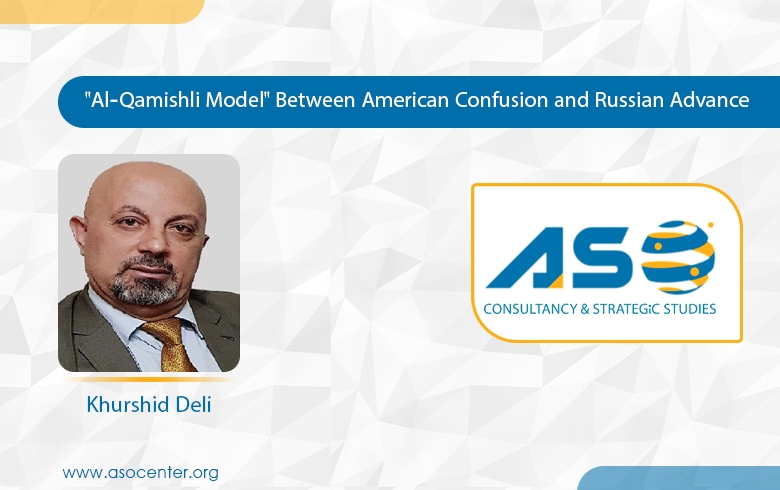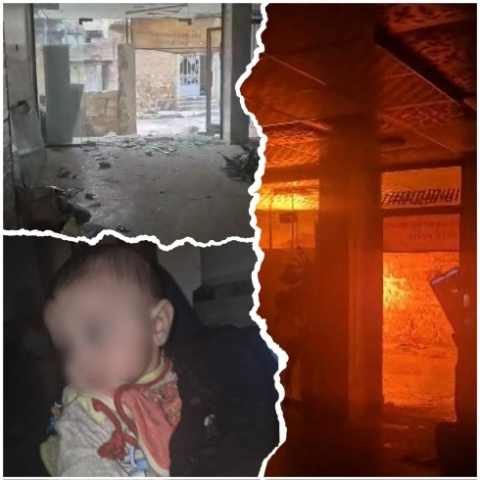

''Al-Qamishli Model'' Between American Confusion and Russian Advance
2020-01-03
Writer: Khurshid Deli, writer and researcher of Turkish and Kurdish affairs.
The term “Qamishli Model” was first introduced during a summit between US President Donald Trump and Russian President Vladimir Putin in Helsinki in February last year, where the aim of this model was to discuss the fate of the Kurds in the Syrian future. The idea of Al-Qamishli Model is basically a Russian idea put forward by Vitaly Naumkin, the latter is an advisor to Putin, Director of the Russian Oriental Institute and an expert on Middle East affairs, where he has long worked in a number of Arab capitals.
What is the Al-Qamishli Model? The idea revolves around two fundamental issues; The first is granting the Kurds some form of local government, provided they do not separate from the central authority in Damascus, and the second issue is to give the local government of the Kurds the possibility of making political and local decisions and partial independence in cultural and economic issues. In fact, the idea of Al-Qamishli Model arose from several factors, perhaps the most important, the emergence of Self-Administration in areas east of the Euphrates in the wake of fighting ISIS, by the vacuum left by the Syrian army's regular withdrawal from these areas for many reasons. This administration seems an urgent need to regulate the reality of social, security and economic life in these areas. Gradually, this administration became a kind of political and military entity that builds its institutions, and open on the outside and make friends. Based on this reality, this administration put forward political projects, where it ranged between confederation and then federalism before it retreated to some form of local government on the impact of developments in the Syrian crisis; Developments that have affected the arc of the Kurdish self-administration's demands, and the perception of international and regional players influencing the Syrian crisis towards these demands of this administration. Perhaps the most prominent of these developments are:
- First, the central development associated with Damascus; this was reflected in the field developments on the impact of the Syrian army's success with Russian and Iranian support in regaining control of large areas, from the Ghouta of Damascus to Daraa south, to large areas in the countryside of Aleppo, Hama and Idlib.
- Second: the Turkish factor. After the occupation of Afrin by Turkey after the Olive Branch operation, the Turkish appetite seems open to control more territory under the control of the Kurdish Self-Administration, the operation (fountain of peace) to deal a big blow to this administration, its projects and aspirations, especially that the Turkish operation necessitated the deployment of the Syrian army in large areas of Manbij west through Kobani- Ain Arab to reach areas in the far northeast on Dijla River.
- Third: the track of Astana and Sochi, where this path began with three parties (Russia, Iran, Turkey) in its political movement against the Western track, especially the US in Syria. On this basis, the three countries pointed their arrows against the US presence and its local ally SDF in eastern Euphrates. This process succeeded in preventing the participation of the Self-Administration in the Constitutional Committee and earlier in the Geneva negotiations, which created enormous pressure against the administration, especially in light of the regime agreement and the opposition against the political proposals of the administration.
- Fourth: after the post ISIS elimination in its last stronghold in Baghouz, east of Deir Ezzor. After this operation, the administration seems to have lost its primary function of fighting ISIS, paving the way for shift the American opinion that dramatically affected Self-Administration.
American Confusion and Russian Advance:
The general feature of President Donald Trump's policy was confusion and improvisation, contrary to the spirit of American strategy. This confusion was evident in the relationship with the Kurds and the US military presence in the eastern Euphrates. The issue of withdrawing US soldiers seemed to be a turning point between Trump's near-daily tweets of assertion of withdrawal and the Pentagon's, Congress's and intelligence's pursuit of a thoughtful withdrawal that does not create dramatic repercussions for the allies and the balances of power. This policy may have confounded many forces, including Trump's allies in the European Union, particularly France and Britain, because of the presence of troops for these two countries in the east of the Euphrates, and talk about the establishment of a safe area with international protection to prevent the clash between Turkey and the Kurds. However, what happened is that Trump's decision to turn things upside down following the famous phone call with his Turkish counterpart, Recep Tayyip Erdogan and the latter's announcement of the launch of Operation (Fountain of Peace) under the pretext of establishing a safe area in northeastern Syria. This process led to the dismemberment of areas under the Self-Administration's control, and opened the door to a new map of forces competing for the geography of eastern Euphrates.
Russia seemed to be the biggest beneficiary with Trump's decision to the extent that Trump handed over the entire Syrian file to Putin. Whenever US troops withdrew from a military base in the eastern Euphrates, Russian forces, accompanied by the Syrian army, filled the void, following the ceasefire, Moscow also moved aggressively on two tracks:
-First, the course of restoring the relationship between Ankara and Damascus in accordance with a modified version of Adana Agreement reached, in 1998, between Damascus and Ankara following the crisis of Abdullah Ocalan between the two countries.
-Second, Moscow's attempt to move along the line of relations between the Kurds and Damascus. Although this move led to a military understanding between the two sides to the deployment of regular Syrian forces in the border areas with Turkey to reduce the Turkish military operation, however, this move has not led to any political results so far in terms of agreement between the Kurds and the regime on a political solution.
In fact, it is clear that Russia is better able to shape the Syrian scene, determine the course of the Syrian crisis and manage the conflict game between the parties involved in this crisis. The Russian decision to establish a military air base at Qamishli airport to protect a missile system is an expression of a decisive Russian strategy to determine future maps in the east of the Euphrates. The establishment of such a base is an expression of a Russian desire for a long, if not permanent, stay in this region, where then it can address more pressure on the United States, Turkey and Iran to push the course of the crisis in accordance with the Russian strategy, which seeks to push these countries to withdraw troops from Syria.
Model between political and cultural:
All the previous developments has put the regime and the SDF face to face with dialogue option in the hope of an agreement between them, preserving the territorial integrity of Syria in the face of the dangers of Turkish aggression, and in the same time achieving a new social contract, recognizing the national identity of the Kurds, and achieving some form of local governance for them.
Faced with this reality, there are many questions to ask, perhaps the most important, can Damascus really recognize the national presence of the Kurds? Is it possible that it accepts the Self-Administration in eastern Euphrates? On the other hand, can the SDF provide a clear speech regarding the final political options? To what extent can it reconcile its domestic demands with the determinants of the relationship with the center?.
With the prior recognition of the different and contradictory views between the regime and SDF on the aspirations of SDF and how to reach an agreement between them, there are limitations may help to a desired dialogue between the parties, and perhaps the most important of these determinants are the following:
1. The two sides agreed on the importance of unity and efforts in confronting the Turkish aggression, as this aggression highlighted the real dangers to Syria in the form of Turkish ambitions on Syrian territory, a strategy for long stay in these territories, albeit indirectly through the forces and factions associated with the Turkish authorities.
2. Russia, which represents itself as the guarantor of the dialogue between Damascus and SDF, although the limits of this role are not yet clear, but succeeded in pushing the parties to reach a military understanding in areas east of the Euphrates. This drew a new map of influence and roles, and although this step is important in this stage, it will remain without real results at the political and strategic level.
3. The nature of the relationship and roles between SDF and Damascus constitute a natural determinant of dialogue, since the relationship between them has not witnessed over the past years both wars or bloody-conflicts. This relationship has often been interrupted, especially in the fight against terrorist organizations and those classified in the opposition, where it should be recalled that meetings have not been interrupted between the two parties for the past period.
In fact, apart from the contradictory positions between Damascus and SDF on the political issues raised, there is a perception in Damascus that the recent developments have weakened the position of SDF and its options, especially under the Russian pressure and the continued Turkish threat.Based on this perception, Damascus proceeds in its conception of dialogue with SDF from the fact that it does not accept its existence as a military institution and self-administration in the future. This perception is against the two fundamental demands of SDF, which are recognition of Self-Administration and recognition of SDF's privacy in the future Syrian army. The SDF model of agreement is a form of political recognition while Damascus, as the Syrian president put forward in his recent interview with Syrian media, revolves around a form of cultural rights. Perhaps his talk and his focus on the Armenian model in Syria of cultural and educational rights was a clear message and addressed to the Kurds more than anything else, that the cultural model alone is at the table of dialogue and response. Faced with this reality, there is a bet from the parties concerned on the factor of time and the change of the balances of power and field developments, to favor the weight of any model on the other in the next stage.



